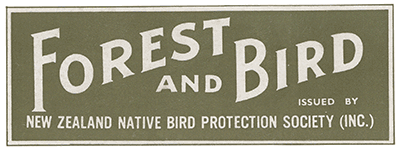- Magazines and Journals
- Explore
- Forest and Bird

Forest and Bird
Background
Region
National
Available online
1924-2004
Also published as:
Birds
Forest and Bird magazine is the flagship publication of the Royal Forest and Bird Protection Society of New Zealand Inc. The Society was founded in 1923 by Captain Ernest “Val” Sanderson and was first known as the New Zealand Native Bird Protection Society. Sanderson started the organisation because he was horrified and angry by what he saw happening on Kāpiti Island. Although designated as a bird sanctuary in 1897, the bush on Kāpiti had not protected from grazing animals such as sheep, and the state of the bush had deteriorated over the war years.
The destruction of the forest in New Zealand had been one of the major reason for the decline in native birds, as had the introduction of predators such as weasels. Collectors and hunters had also played a role. The Society, which became formally known as the Forest and Bird Protection Society from 1934, campaigned for the establishment of national parks, the eradication of predators, the development of island sanctuaries, and the protection of native birds from hunting and shooting.
The Society’s magazine started as a newsletter from Sanderson to members in 1923. It was one to two pages in length and sent out as a circular letter. These evolved into a magazine called Birds, published from September 1924. The first issue of Birds started with this thundering command from entomologist J. G. Myers. ‘It is the duty of every New Zealander to do his best towards the permanent preservation of those natural beauties with which this country is so lavishly endowed.’ (September 1924: 1)
Birds was published twice a year until 1928, when it changed to three times a year. In October 1933 the name of the magazine was changed to Forest and Bird, to better reflect the importance of retaining the bush in order to save the birds. In 1935 the decision was made to publish quarterly, in February, May, August and November, a pattern that is still followed in 2019.
From the earliest issues, the magazine included articles from prominent overseas writers on environmental matters, linking the New Zealand Society to conservation movements in Britain and the United States in particular. Many New Zealand scientists were members of the Society, such as ornithologist Robert A. Falla, and botanists Bernard C. Aston and Leonard Cockayne, and they contributed many articles to the magazine.
From August 1933 onwards the cover of Forest and Bird featured the colourful bird paintings of Lily Daff (1885-1945). Daff had been commissioned by the Society to produce a series of paintings showing New Zealand birds in 1932. These were used on the cover of the magazine, as well as in two Society publications, New Zealand Forest-Inhabiting Birds (1933) and New Zealand Sea and Shore Birds (1940). Her original works are now held in the Alexander Turnbull Library.
In 2019 the Society was the leading independent advocate for the protection of New Zealand’s environment, with 48 branches, 54 paid staff and over 70,000 members. It is the longest-lived environmental association in New Zealand and its magazine is the longest-running New Zealand publication about conservation issues.
Copyright statement
For material that is still in copyright, Forest & Bird have made it available under a Creative Commons Attribution-NonCommercial 4.0 International licence (CC BY-NC 4.0). This periodical is not available for commercial use without the consent of Forest & Bird. For advice on reproduction of out-of-copyright material from this magazine please refer to our copyright guide.
Forest & Bird has made best efforts to contact all third-party copyright holders. If you are the rights holder of any material published in Forest & Bird's magazine and would like to discuss this, please contact Forest & Bird at editor@forestandbird.org.nz
Acknowledgements
This material was digitised in partnership with The Royal Forest and Bird Protection Society of New Zealand Inc.
 Log in
Log in